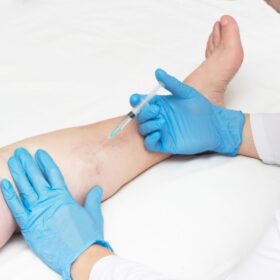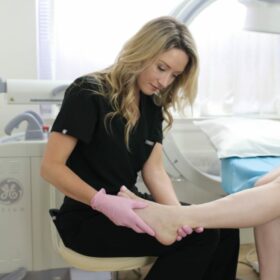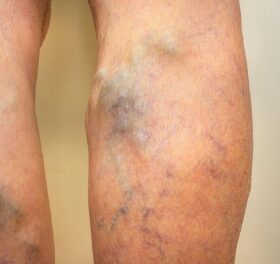If you suffer from varicose veins, you may be looking for a non-surgical and minimally invasive treatment option. One such option is sclerotherapy, which involves injecting a solution directly into the treated vein to cause it to collapse and eventually fade away. But what is the success rate of sclerotherapy? In this article, we’ll take a closer look at this treatment, its success rate, and what you can expect during and after the procedure.
What is Sclerotherapy?
Sclerotherapy is a minimally invasive treatment for varicose veins and spider veins. The procedure involves injecting a solution directly into the treated vein, causing it to collapse and eventually fade away. This solution irritates the lining of the blood vessel, causing it to swell and stick together. Over time, the treated vein will turn into scar tissue and be absorbed by the body, leaving no trace of the previous vein. Sclerotherapy is typically done in an outpatient setting, and the procedure can take between 15 minutes to an hour, depending on the size and number of veins being treated.
How Does Sclerotherapy Work?
Sclerotherapy works by injecting a solution directly into the treated vein, which causes the vein to collapse and eventually fade away. The solution irritates the lining of the blood vessel, causing it to swell and stick together. Over time, the treated vein will turn into scar tissue and be absorbed by the body.
During the procedure, the doctor will use a fine needle to inject the solution into the injection site, usually located on the leg. If the vein being treated is a larger vein, the doctor may use ultrasound to guide the needle to the correct location. The number of injections needed will depend on the size and number of veins being treated.
After the injection, the doctor will apply pressure to the treated area to prevent bleeding and encourage the vein to collapse. The treated area may be wrapped in compression bandages, and the patient will be instructed to wear compression stockings for a period of time after the procedure.
What is the Success Rate of Sclerotherapy?
The success rate of sclerotherapy varies depending on several factors, including the size and number of veins being treated, the patient’s age and overall health, and the skill and experience of the doctor performing the procedure. Sclerotherapy has a success rate of up to 80 percent in treating small varicose veins and spider veins. Larger veins may require multiple treatments, and the success rate may be lower. However, sclerotherapy is an effective and safe treatment option for varicose and spider veins.
What to Expect During and After Sclerotherapy?
During the sclerotherapy procedure, patients may experience a mild burning or stinging sensation at the injection site. This sensation is usually short-lived and should subside quickly. Patients can resume normal activities immediately after the procedure, but they should avoid strenuous exercise and activities for the first few days.
After the procedure, patients may experience some soreness and bruising in the treated area for a few days. This is normal and should not be a cause for concern. The patient may also experience itching or swelling in the treated area. Compression stockings should be worn for a period of time after the procedure to promote healing and prevent blood clots from forming. Compression stockings help to improve blood flow in the legs and reduce the risk of complications such as deep vein thrombosis.
It is important for patients to follow their doctor’s instructions carefully after the procedure. Patients should avoid standing or sitting for long periods of time and should elevate their legs when possible. This helps to reduce swelling and improve blood flow in the legs. Patients should also avoid hot baths, saunas, and direct sunlight exposure to the treated area for a few days after the procedure.
When to See a Doctor?
While sclerotherapy is generally safe and effective, there are some risks associated with the procedure. These risks include bleeding, infection, and allergic reaction to the solution used. If you experience the following symptoms after sclerotherapy, you should seek medical attention:
- Severe pain or discomfort in the treated area
- Redness, swelling, or warmth in the treated area
- Bleeding or oozing from the injection site
- Fever or chills
- Shortness of breath or chest pain
- Sudden swelling or redness in the leg
Sclerotherapy is a safe and effective treatment option for varicose veins and spider veins. The success rate of sclerotherapy varies depending on several factors, including the size and number of veins being treated and the skill and experience of the doctor performing the procedure. In most cases, sclerotherapy is an effective and safe treatment option for varicose veins and spider veins. However, it is important to follow your doctor’s instructions carefully to ensure the best possible outcome and avoid any complications.
Visit Vein Treatment Clinic for Sclerotherapy
At Vein Treatment Clinic, we specialize in minimally invasive spider vein and varicose vein treatments, such as sclerotherapy, endovenous laser ablation, radiofrequency ablation, VenaSeal, ClariVein, and ambulatory phlebectomy. We always diagnose the root cause of spider veins and varicose veins via vascular imaging and duplex ultrasound before curating a personalized treatment plan. Our vein clinics are led by board-certified vein doctors, and we offer hassle-free insurance verification even before the first appointment.
We have state-of-the-art locations across the United States, including New York, New Jersey, Long Island, California, and Washington DC. If you’re interested in learning more about sclerotherapy or any of our other treatment options, contact us today to schedule a consultation with one of our vein specialists.












